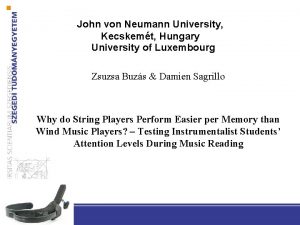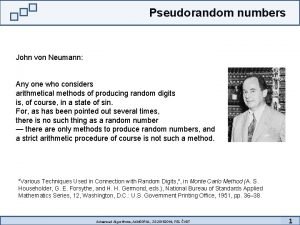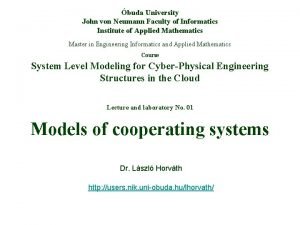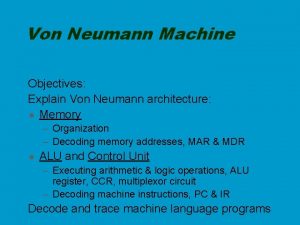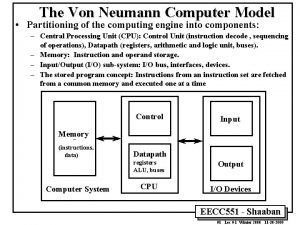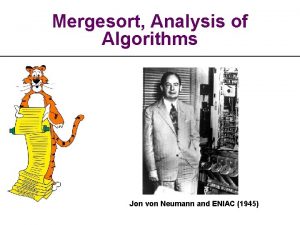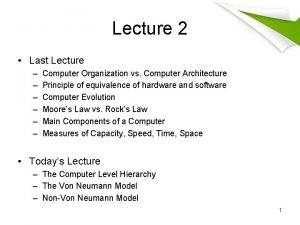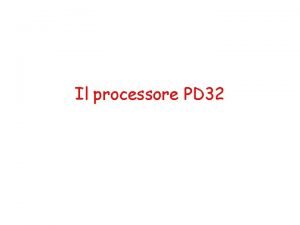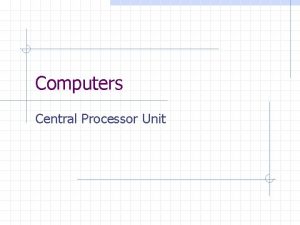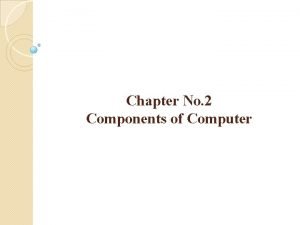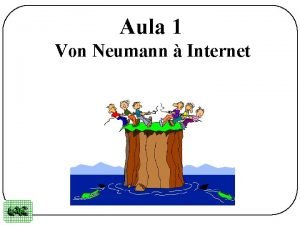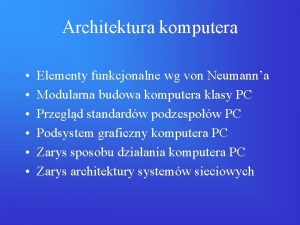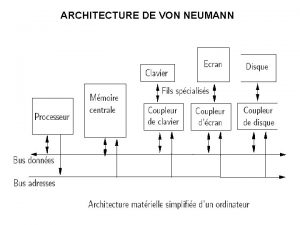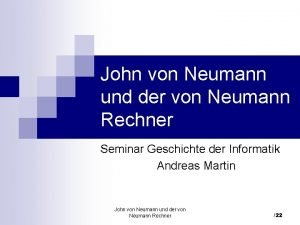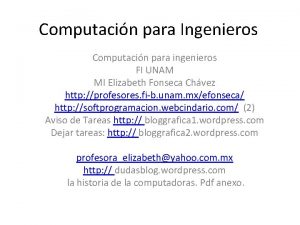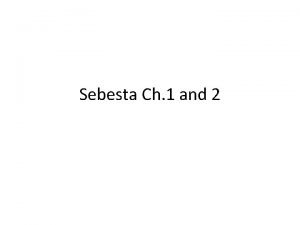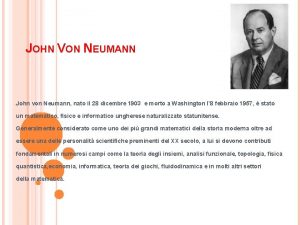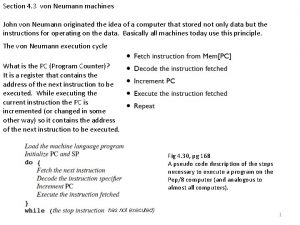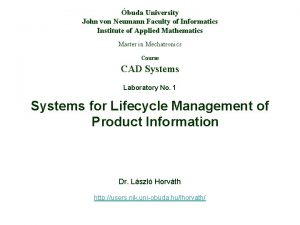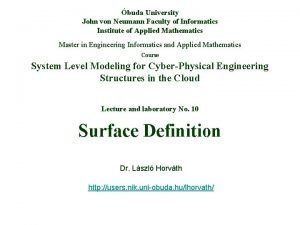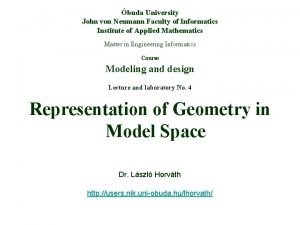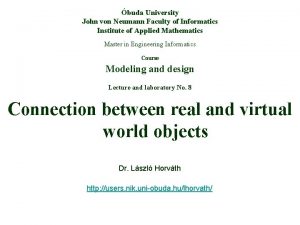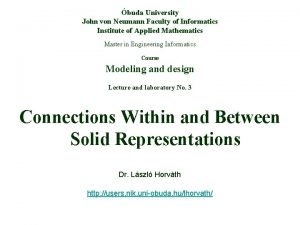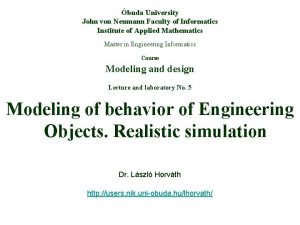John von Neumann University Kecskemt Hungary University of































- Slides: 31

John von Neumann University, Kecskemét, Hungary University of Luxembourg Zsuzsa Buzás & Damien Sagrillo Why do String Players Perform Easier per Memory than Wind Music Players? – Testing Instrumentalist Students’ Attention Levels During Music Reading

Music and the brain


Key brain areas associated with music processing studies of healthy subjects O’Kelly, Voices, 2016

The concept of music reading • The fast and automated recognition of images and symbols are cognitive factors that determine the development of reading (Csépe, 2014). • The ability to understand enjoy the music primarily depends on how much we know about the patterns in music and how many associations are involved in the emotional content. • It is essential for the music playing from memory to understand the structures of the compositions, and to know the boundaries of musical phrases and motifs and their connection to the piece (Asztalos & Csapó, 2015).

Effects of musical structure • The development of reading comprehension and the vocabulary are therefore closely related, and reading comprehension requires that the reader understands at least 95% of the words of the text (Schoonen & Verhallen, 1998). • An important characteristic of texts intended for reading is how easily they can be read and the extent to which they are suitable for students as regards the structure of the text and other characteristics. • The readability index is a numeric value expressing how easy a piece of text is to read. • It can be calculated from the length of words and sentences in the text. The easier the text, the higher the value of this number. • The highest possible value of the index is about 120, which would be found for the easiest texts. The texts with a value of 90– 100 can be recommended for 10– 11 -year-old children. • Texts at the other end of the scale are characterized by values below 30 and are suitable for reading by university students. • The Flesch-Kincaid Grade Level provides information about the grade from which students would understand the given piece of text, i. e. from which grade on it can be recommended for reading

The role of motivation • The content and the different tasks of music and Solfege textbooks play a prominent role in helping teachers to develop student’s music reading skills. • The diversity, quality, and processing skills of the texts are closely related to the success of reading (Józsa & Steklács, 2012). • The reading motivation of students is of utmost importance, i. e. the kind of texts and methods are used. • Playing music is a beloved activity among instrumentalist students. Frequent reading can thus provide them an increased number of exercise opportunities that can compensate for many years of schooling or the worse socio-economic situation (Guthrie & Wigfield, 2000).

Research fields of music reading • • Online assessment Eye-tracking technology EEG Elektro Enkefalográf Neuro. Sky Mindwave simple - portable device


10 years 14 years Luxembourg N=19 boys 9 3 girls 5 2 Germany N=16 boys 3 2 girls 5 6 Hungary N=18 boys 6 5 Total girls 5 33 2 20


Investigate of students’ attention levels in classroom settings with Neuro. Sky’s Mind. Wave Mobile (EEG) Device • A general definition of attention is that of the mind focusing on a given activity. • Theory of information processing claims that information first goes through attention and selective perception before its transfer to sensual recording, short-term memory, and longterm memory. • Attention can therefore be claimed to be a prerequisite to learning (Schunk, 2009) and a factor that facilitates it (Kruschke, 2000; Schmidt, 2001).

• EEG device that translates brainwaves into digital information and beams it wirelessly to the computer. • Neuro. Sky’s Mind. Wave was developed directly as a biosensor to read the electric activities of the brain in detecting its states of attention and relaxation. • As pedagogical neurofeedback it is used to increase the students` capabilities in controlling their attention and concentration in learning situations. • Class participation and attention levels affect student motivation, & a highly motivated student displays high levels of attention and class participation (Fidan, 1996; Schunk, 2008). • Class participation is crucial in that it raises the quality of learning. • There exist a moderate, positive correlation between students’ attention levels and class participation (Sezer et al. , 2017).

• Flow was examined during learning performance, it depends on the challenge-skill balance of learning materials (Wang, 2014). • Test the possibility of multiple readings of students’ attention levels in real classroom settings by means of Neuro. Sky’s Mind. Wave EEG device. Powerpoint presentation, digital maps used in lesson increase students’ attention levels, & lectures without any teaching material decrease their attention levels (Sezer, et al. ). • Yang, Chien, and Tseng (2013) Power. Point presentations raise students’ attention levels.

A smoothed attention level record can be seen. We received quite noisy signals because of high sampling rate, that’s why the smoothing. At „break downs” we recorded the student changed among exercises. The other student needed much more attention to finish the exercises. Attention level changes when switching exercises Most significantly the fatigue was recognized when pianists playing a sheet music. Fatigue can be detected

EEG Bandwidth and corresponding mental state and condition Type Frequency (Hz) Mental state and conditions Delta 0 -3. 5 Deep, sleep, non-REM sleep, unconscious Theta 4 – 7 Intuitive, recall, fantasy, imaginary, dream Alpha 8 - 12 Relaxed, but not drowsy, tranquil, conscious Beta Low 13 - 15 Relaxed yet focused, integrated Mid. 16 – 20 Thinking, aware of self & surroundings High 21 - 30 Alertness, agitation Gamma >31 Motor functions The EEG device captures the brain waves in the Beta interval, produces an original value, and scales it between 1 and 100. Natural state is between 40 and 60. 20 -40 is slightly low. 60 to 80 is slightly high. 80 to 100 is very high.


Research • The study aims to test instrumentalist students’ attention and mediation levels during music reading by means of Neuro. Sky’s Mind. Wave EEG device. • We investigated wind instrumentalists, 12 -14 years of age, and compared them with violin players matched for age and grade level. • The research was carried out in 2 music schools in March 2018 (Dr. Márta Janurik) • Students were asked to play an eight-bar composition of Szilvay – Colour String Method, based on the Kodály concept. • We analyzed attention and mediation levels, blinks (alpha, beta and gamma band oscillatory responses) to the musical piece during reading.





Results • Attention and meditation data is scaled between 1 and 100. • The findings from the study revealed that the average of the attention levels of the violin players was slightly high; 61. 53. • The attention level of the wind players was 39. 98, that is slightly low. • Significant difference was found between the averages of attention level between the string and the wind players (t=2. 656, p=0. 026).

Attention Mediation Blink Instrument violin trumpet tenorhorn Total N 21 18 2 41 Mean 61. 53 41. 41 34. 27 52. 55 Instrument violin trumpet tenorhorn Total N 21 18 2 41 Mean 54. 01 50. 56 58. 54 53. 24 Instrument N Mean violin trumpet tenorhorn Total 21 18 2 41 53. 53 49. 78 44. 90 51. 56

% 60. 00 55. 00 54. 09 54. 47 52. 06 51. 19 50. 00 45. 00 attention 40. 00 mediation 35. 00 30. 00 25. 00 20. 00 15. 00 10. 00 5. 00 0. 00 age 12 age 14

% 60. 00 56. 53 55. 73 55. 00 50. 00 49. 76 47. 00 boy 45. 00 girl 40. 00 35. 00 30. 00 25. 00 20. 00 15. 00 10. 00 5. 00 0. 00 attention mediation

During playing Attention Mediation Silent reading attention Silent reading mediation N 41 41 Mean 60. 43 59. 88 SD 61. 53 4. 76 Min. 42. 02 54. 51 Max. 69. 91 67. 63 41 41 56. 99 44. 96 21. 96 12. 51 32. 54 44. 96 81. 30 80. 48 Gender Girls Mean 37. 41 SD 6. 89 Boys Girls 66. 78 60. 99 20. 13 2. 21 Boys 57. 40 15. 92

90. 00 80. 00 76. 40 74. 23 75. 39 70. 00 72. 64 69. 91 69. 01 65. 68 60. 00 50. 00 64. 31 60. 70 62. 84 62. 23 61. 05 57. 98 56. 92 56. 70 53. 12 49. 69 68. 60 67. 63 67. 60 65. 90 57. 24 54. 51 55. 22 49. 10 46. 34 59. 90 58. 65 56. 6355. 43 51. 63 48. 58 45. 43 40. 00 40. 87 42. 57 42. 02 30. 00 20. 00 10. 00 p 1 attention p 1 meditation peti p 1 blink anna andras p 2 attention andris flora p 2 meditation rebeka p 2 blink

Conclusions & directions for future research • There are differencies in the attention and concentration level during silent and loud music reading among different instrumentalist – similar to the results of eye-tracking research • Differencies between gender and age groups. • Developing training programs of music reading comprehension based on the level of attention, and motivation.


Thank you for your kind attention!
 John von neumann university
John von neumann university Kecskemt
Kecskemt John von neumann institute
John von neumann institute John von neumann random number generator
John von neumann random number generator John von neumann schema
John von neumann schema Relance poker
Relance poker John louis von neumann
John louis von neumann John von neumann born
John von neumann born John von neumann computadora
John von neumann computadora John von neumann poker
John von neumann poker John von neumann schema
John von neumann schema Arquitectura alu
Arquitectura alu Jnfi
Jnfi Characteristics of von neumann architecture
Characteristics of von neumann architecture Von neumann model components
Von neumann model components Gargalo de von neumann
Gargalo de von neumann Jon von neumann
Jon von neumann Sexitillion
Sexitillion Modello di von neumann spiegazione semplice
Modello di von neumann spiegazione semplice Von neumann
Von neumann Von neumann model components
Von neumann model components Non von neumann model
Non von neumann model Estrutura de von neumann
Estrutura de von neumann El modelo de von neumann
El modelo de von neumann Architettura di non von neumann
Architettura di non von neumann Architektura neumanna
Architektura neumanna Von neumann test
Von neumann test Von-neumann-rechner
Von-neumann-rechner Schema von neumann
Schema von neumann Modelo de von neumann unam
Modelo de von neumann unam Von neumann
Von neumann Von neumann
Von neumann
